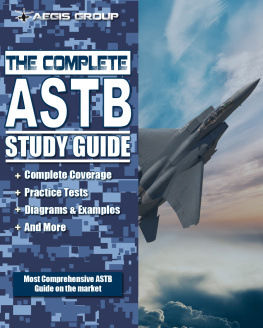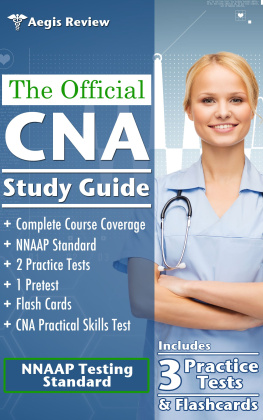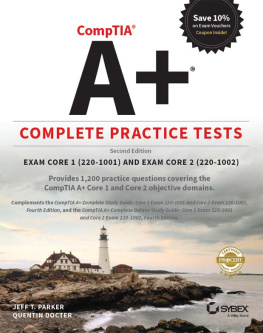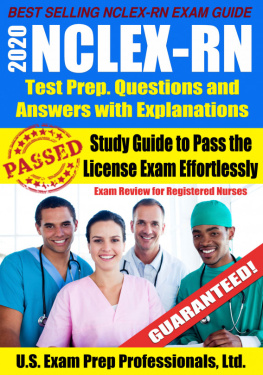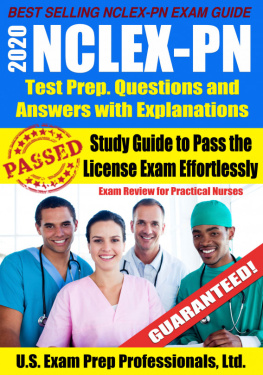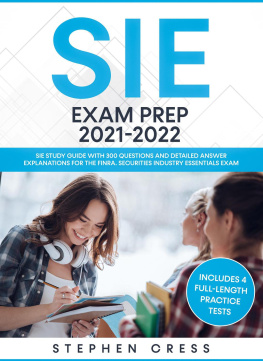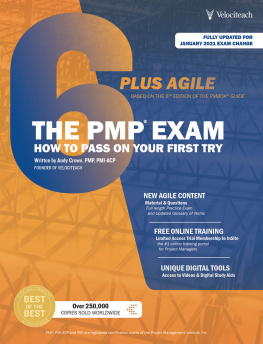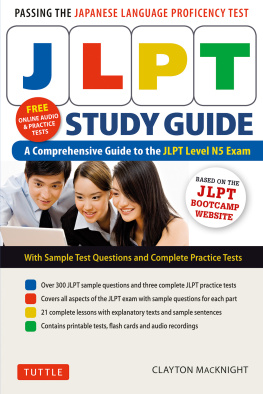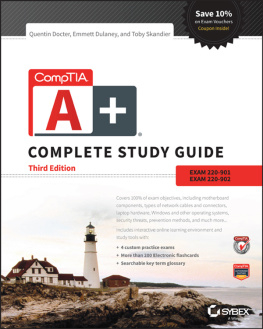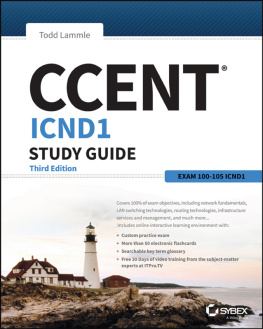The Complete ASTB Study Guide
ASTB Practice Tests And Preparation Guide for the ASTB Exam
John Mackey
The Complete ASTB Study Guide
Copyright 2017
All rights reserved. This book or parts thereof may not be reproduced in any form, stored in any retrieval system, or transmitted in any form by any meanselectronic, mechanical, photocopy, recording, or otherwisewithout prior written permission of the publisher, except as provided by United States of America copyright law.
Disclaimer
Every effort has been made to ensure that the content provided on this book is accurate and helpful for our readers at the time of publishing. However, this is not an exhaustive treatment of the subjects and as you probably know, the Department of State could change their testing practice or layout to the ASTB selection process at any moment. No liability is assumed for losses or damages due to the information provided. You are responsible for your own choices, actions, and results.
This book is dedicated to the brave men and women who serve the United States armed forces. Without your vigilance we wouldnt have the freedom and liberty we have today.
Useful External ASTB Resources
Navy Medicines answers to the most commonly asked ASTB questions
www.med.navy.mil/sites/nmotc/nami/Pages/ASTBFrequentlyAskedQuestions.aspx
Official site dedicated to Naval history
www.history.navy.mil
An MIT website explaining the basic physics of flight
web.mit.edu/16.00/www/aec/flight.html
A list of free flight simulators (helpful for the PBM section of the ASTB)
www.digitaltrends.com/gaming/best-free-flight-simulators/
A YouTube channel showing both practical and theoretical aspects of airplane flight
www.youtube.com/user/profpilotcouk/videos
A YouTube channel with in-depth documentaries about Naval History and various craft
www.youtube.com/user/WarsChannel10/videos
ASTB Introduction
Becoming a flight officer in the Navy, Marine Corps, or Coast Guard is one of the most desirable careers in the entire military. It is also one of the most competitive. The ASTB-E, or Aviation Selection Test Battery to give it its full name, is the series of tests used to determine whether a candidate shows aptitude for flight training and represents a good prospect for success at later stages of the training program.
The ASTB-E is the most recent and up to date version of the test, with a range of adaptations and upgrades from previous versions of the ASTB. However, for the sake of brevity, this book will refer to the test as the ASTB from this point forward. At all times, this is referring to the ASTB-E however, and the information is the most up to date possible for the latest version of the Test Battery.
The military uses a testing platform called Automated Pilot Examination, commonly abbreviated as APEX. The ASTB is tested through this platform only, meaning that your test will be in an electronic format.
Making the Most of Your ASTB Study Guide
Each section of this ASTB study guide consists of several sections: Purpose, Contents, Preparation, Practice Test, and Practice Test Answer Key.
The Purpose section of each chapter explains the reason why the ASTB features this particular test. Its been proven that understanding the purpose and reason behind a test increases ones motivation to study for it. The Purpose section is therefore a proven way of increasing your motivation for a particular section, as well as explaining to you how it may be useful to your future Aviation career.
The Contents section breaks down the type of material you are likely to encounter during that portion of the ASTB. All the information in this guide has been taken from test takers reporting the type of content they faced. This ensures that all the material you cover stands a good chance of being found on the ASTB.
The Preparation section gives tips for studying and ways of processing the information. These sections have been written with different learning styles in mind, and they are intended to be useful for those seeking optimum strategies to absorb and retain the information.
The Practice Test section features a range of questions to test your knowledge and application of the chapters content.
The Practice Test Answer Key allows you to quickly and easily check your answers for each section of the ASTB practice test. This is vital to identify areas that are understood well, and those which require additional study and practice.
ASTB Sections
The ASTB consists of seven sections. Below are the full names for each section, the abbreviations by which they are commonly known, and the most essential information about each section.
1. Math Skills Test (MST)
Consists of between 20 and 30 multiple choice questions. This is a computer adaptive section, meaning the exact number and nature of the test questions you receive will vary depending upon your previous answers.
2. Reading Comprehension Test (RCT)
Between 20 and 30 multiple choice questions, as determined by the computer adaptive testing system. Each question consists of a passage of text and four possible answers. Only one answer is definitely true based on the text passage given, although all may seem related or initially plausible.
3. Mechanical Comprehension Test (MCT)
Between 20 and 30 multiple choice questions, as determined by the computer adaptive system. Each question tests either a practical or theoretical aspect of mechanics and physics, ranging from abstract concepts (such as Newtons Laws) to applied ideas (such as the stages of an engines operation).
4. Aviation and Nautical Information Test (ANIT)
Between 20 and 30 multiple choice questions relating to the practical aspects of flight, such as how an airport operates, the history of the Navy, and information relating to Naval aircraft and ship naming conventions. The number of questions is determined by the computer adaptive system.
5. Naval Aviation Trait Facet Inventory (NATFI)
A type of personality test in which you are given a pair of statements and asked to choose between them. This section cannot be studied for. You should answer honestly rather than trying to game the system, as it is designed to identify any deceptive answers via the way the questions are worded. This is intended to determine whether you have the personality traits that correlate with success in Naval Aviation training.
6. Performance Based Measures Battery (PBM)
This is the most hands-on, practical portion of the ASTB. It involves the use of an imitation throttle, joystick, and headset. It does not test actual flying ability, rather, it tests your ability to multitask, your manual dexterity, and your ability to process information while filtering out distractions.
7. Biographical Inventory with Response Validation (BI-RV)
This section of the ASTB can be completed at a different time than your main test. It basically checks your personal background, including any aviation experience youve had. This can be taken via any computer connected to the internet. It is generally suggested to take this portion of the ASTB before taking the other sections.
ASTB Scoring
The ASTB score you receive will depend upon which sections of the test you take and your purpose for taking the test.
If you are in the Navy and attempting to enter Officer Candidate School, then you will receive a score based on the first three sections of the test only the MST, RCT and MCT. This score will be your Officer Aptitude Rating, or OAR. The score range you can receive for the OAR portion of the ASTB is between 20 and 80. The minimum OAR score needed for consideration by Navy Officer Candidate School is 35.

